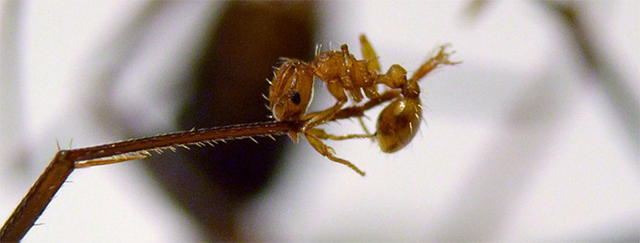Finding Natural Enemies for Little Fire Ants

One of Foundation for the Study of Invasive Species (FuEDEI)’s main projects, the little fire ant (Wasmannia auropunctata; LFA), is an invasive ant native to South America. The LFA has become a major agricultural problem in Hawaii, and a spreading invader in the continental U.S.
Scientists from FuEDEI and Center for Medical, Agricultural and Veterinary Entomology (CMAVE) in Gainsville, Florida are identifying microorganisms, such as viruses, with next-generation sequencing (genomic tools) to discover natural enemies that may be used as biological control agents against the LFA.
In addition, scientists from FuEDEI, CMAVE and the University of Buenos Aires are studying what factors enable the LFA to become invasive and destructive. This study will lead toward the development of management strategies to control this species.
Toward this goal, research is initiated to understand important factors in LFA’s increased invasiveness when introduced to the U.S.
Evidence indicates that in human-modified habitats, both in its native and invasive ranges, there is a shift from a sexual reproductive system, to a clonal system in which each colony hosts many sibling queens. This shift results in “supercolonies” with a decrease in territoriality and aggression between colonies.
The decline of inter-colonial aggression allows for a higher number of ant colonies per area unit, and a stronger negative impact on competing ant species. As these supercolonies are more associated to man-modified environments and are more populated, they have much higher potential of being transported across borders and invade new areas.
This research is expected to provide elements to anticipate the potential extension of the LFA invasion, which is useful to determine where to invest containment efforts, and hopefully a suite of microbial biocontrol agents that could limit the ant’s dispersal and density.
Author: Guillermo Cabrera Walsh, gcabrera@fuedei.org
The Foundation for the Study of Invasive Species (FuEDEI), formerly known as the South American Biological Control Laboratory (SABCL), is located in Hurlingham, Argentina, near Buenos Aires. The SABCL/FuEDEI plays a crucial role collecting and providing candidate biological control agents for South American weeds and pest insects for federal and state cooperators, several U.S. universities, and research collaborators worldwide since 1962. FuEDEI’ s main mission includes exploring for natural enemies of target insects and weeds in Argentina and neighboring countries and conducting host-specificity testing to determine their safety for eventual release in the U.S. In addition, complementary research that investigates the ecology, behavior, taxonomy, and genetic differences based on geographic distribution is conducted on both targets and potential agents. Performing these studies in the region of origin of the target pest serves as an efficient prescreening process that reduces the number of biocontrol agent candidates shipped. This reduces the amount of quarantine work and valuable quarantine space occupation, the expenses related to permitting processes, the risks of escapes, and the release of maladapted or wrongly identified agents to a minimum, saving in costs and hazards. On some occasions these complementary studies help us understand why an exotic organism becomes invasive, which can, in turn, lead to determining novel strategies for their management.
